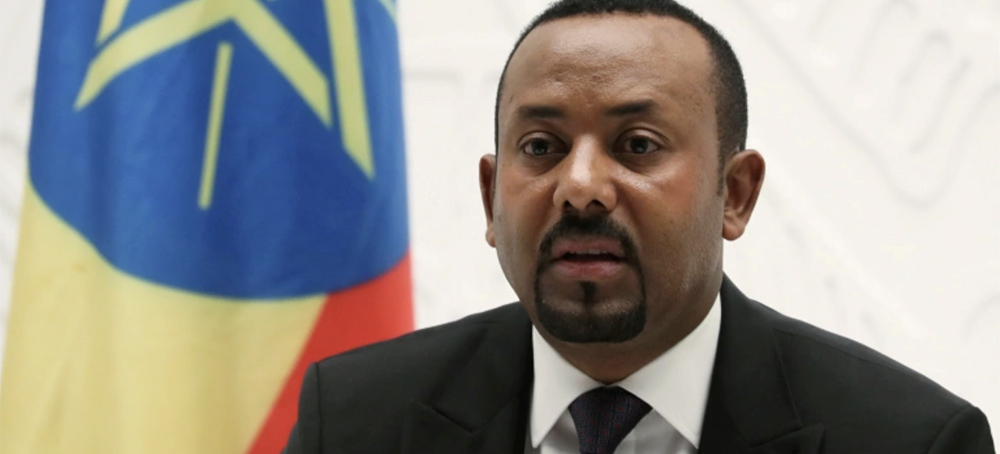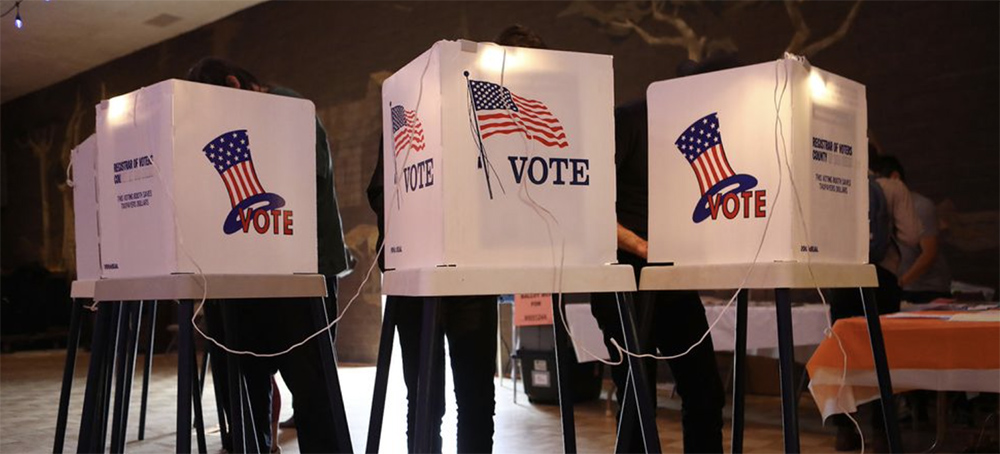Live on the homepage now!
Reader Supported News
The Federal Election Commission has ruled foreign donors can influence American ballot initiatives.
Foreign nationals are barred from donating to U.S. political candidates or committees. But the FEC's decision — allowing them to support ballot committees — provides another avenue for foreigners to directly influence U.S. voters and domestic policy.
A major question stemming from the decision is whether foreign nationals are now permitted to spend money to influence the actual mechanisms of the U.S. democratic process. That would include congressional redistricting, which is frequently subject to ballot referenda. The FEC's ruling did not address that question, meaning it will likely be litigated in future fights at the commission.
It ought to surprise nobody that Montana figures in the opening paragraph of the FEC’s ruling. Montana’s long history as a mining bonanza made it first a target-rich environment for political corruption. In reaction to that, the state enacted a complete ban on any kind of corporate contributions to any campaign in Montana. That ban lasted right up until the Citizens United ruling, when the Montana rules were some of the first state campaign-finance regulations to fall. In this latest action, we're once again talking about political contributions, Montana, and mining corporations.
This matter involves allegations that that Sandfire Resources America, Inc. ("Sandfire") and Sandfire Resources NL ("Sandfire NL") violated the Federal Election Campaign Act of 1971, as amended (the "Act"), by making prohibited foreign national donations to the Montana Mining Association ("MMA") and Stop 1-186 to Protect Mining and Jobs ("Stop 1-186") for the purpose of opposing a Montana ballot initiative that the Complaint states would "increase [Montana's] ability to deny permits for hardrock mines ... to avoid polluting the state's waters.” The Complaint further alleges that MMA and Stop 1-186 also violated the Act by knowingly accepting such donations...respondents do not dispute the facts alleged in the Complaint. Rather, they argue that ballot initiatives are not "elections" under the Act and that, therefore, the Act's foreign national prohibition does not apply to their activities.
Sandfire is an Australian subsidiary of a Canadian mining behemoth, and there are no more voracious corporations on Earth than those of the Canadian extraction industries. But any multinational corporation can now come galumphing in on local referenda and, suddenly, the safety of your drinking water is in the hands of come faceless board of directors halfway across the world. This is the kind of thing that the FEC was designed to stop. If it can’t do that, its purpose is withered and its mandate is dissolved.
 Donald Trump. (photo: Getty Images)
Donald Trump. (photo: Getty Images)
Note for TomDispatch Readers: For those of you who contributed to TomDispatch to get signed copies of William deBuy’s new book, The Trail to Kanjiroba: Rediscovering Earth in an Age of Loss, be patient. He won’t be able to send them out until early November, but they will be coming, many thanks to all of you. And as ever, just a small reminder that anyone who wants to help keep this website afloat in tough times, please visit our donation page and do your best. I’ll be forever appreciative! Tom
-Tom Engelhardt, TomDispatch
Welcome to the American Century
Even If It Is a Hell on Earth
And he wasn’t wrong, was he? Eight decades later, who would deny that we’ve lived through something like an American century? After all, in 1945, the U.S. emerged triumphant from World War II, a rare nation remarkably unravaged by that war (despite the 400,000 casualties it had suffered). With Great Britain heading for the imperial sub-basement, Washington found itself instantly the military and economic powerhouse on the planet.
As it turned out, however, to “exert upon the world the full impact of our influence,” one other thing was necessary and, fortunately, at hand: an enemy. From then on, America’s global stature and power would, in fact, be eternally based on facing down enemies. Fortunately, in 1945, there was that other potential, if war-ravaged, powerhouse, the Soviet Union. That future “superpower” had been an ally in World War II, but no longer. It would thereafter be the necessary enemy in a “cold war” that sometimes threatened to turn all too hot. And it would, of course, ensure that what later came to be known as the military-industrial complex (and a nuclear arsenal capable of destroying many planets like this one) would be funded in a way once historically inconceivable in what might still have passed for peacetime.
In 1991, however, after a disastrous war in Afghanistan, the Soviet empire finally collapsed in economic ruin. As it went down, hosannas of triumph rang out in a surprised Washington. Henry Luce, by then dead almost a quarter of a century, would undoubtedly have been thrilled.
The Indispensable Superpower
In the meantime, in those cold-verging-on-hot-war years, the U.S. ruled the roost in what came to be known as “the free world,” while its corporations came to economically dominate much of the planet. Though it would be a true global imperial power with hundreds of military bases scattered across every continent but Antarctica, there would prove to be significant limits to that power — and I’m not just thinking of the Soviet Union or its communist ally (later opponent), Mao Zedong’s China.
At the edges of what was then called “the Third World” — whether in Southeast Asia during and after the disastrous Vietnam War or in Iran after 1979 — American power often enough came a cropper in memorable ways. Still, in those years, on a planet some 25,000 miles in circumference, Washington certainly had a remarkable reach and, in 1991, when the Soviet Union disappeared, it seemed as if Luce had been a prophet of the first order. After all, the United States as the ultimate imperial power had — or so, at least, it appeared at that moment — been left without even a major power, no less another superpower, as an enemy on a planet that looked, at least to those in Washington, like it was ours for the taking. And indeed, take it we soon enough would try to do.
No wonder, in those years, American politicians and key officials filled the airwaves with self-congratulation and self-praise for what they liked to think of as the most “exceptional,” “indispensable,” “greatest” power on the planet and sure to remain so forever and a day.
In another sense, however, problems loomed instantly. Things were so desperate for the military-industrial complex in a country promised a cut in “defense” spending, then known as a “peace dividend,” thanks to the triumph over the Soviets, that enemies had to be created out of whole cloth. They were, it turned out, fundamental to the organization of American global power. A world without them was essentially inconceivable or, at least, inconvenient beyond imagining. Hence, the usefulness of Iraqi autocrat Saddam Hussein who would be not-quite-taken-down in the first Gulf War of 1991.
Perhaps the classic example of the desperate need to create enemies, however, would occur early in the next century. Remember the “Axis of Evil” announced (and denounced) by President George W. Bush in his January 2002 State of the Union address? He called out three states — Iran, Iraq, and North Korea — that then had not the slightest way of injuring the U.S. (“States like these, and their terrorist allies,” insisted the president, “constitute an axis of evil, arming to threaten the peace of the world. By seeking weapons of mass destruction, these regimes pose a grave and growing danger. They could provide these arms to terrorists, giving them the means to match their hatred. They could attack our allies or attempt to blackmail the United States. In any of these cases, the price of indifference would be catastrophic.”) Of course, this was, in part, based on the claim that Iraq might have just such weapons of mass destruction (it didn’t!) and that it would, in turn, be willing to give them to terror groups to attack the U.S. That lie would become part of the basis for the invasion of that country the next year.
Think of all this as the strangest kind of imperial desperation from a superpower that seemed to have it all. And the result, of course, after Osama bin Laden launched his air force and those 19 mostly Saudi hijackers against New York and Washington on September 11, 2001, was the Global War on Terror, which would soon prove a self-imposed, self-created disaster.
Or think of it another way, when considering the imperial fate of America and this planet: the crew who ran Washington (and the U.S. military) then proved — as would be true throughout the first two decades of the twenty-first century — incapable of learning even the most basic lessons history had to offer. After all, only a decade after the Soviet Union collapsed, thanks in significant part to what its leader called its “bleeding wound,” a disastrous war in Afghanistan in which the Red Army became endlessly mired, the Bush administration would launch its own disastrous war in Afghanistan in which it would become — yep, endlessly mired. It was as if this country, in its moment of triumph, couldn’t help but take the Soviet path into the future, the one heading for the exits.
Cold Wars and Hot Wars
In November 2021, just three decades after the implosion of the Soviet Union, no one could imagine any longer that such a vision of victory and success-to-come caught the underlying realities of this country or this century. The arrival of Donald Trump in the White House five years earlier had been the most visible proof of that.
It’s hard to imagine today that he wasn’t the truest of all products of that very American Century, a genuine message from it to us and the rest of the world. He was, after all, the man who, in his key slogan in 2016 as this country’s first declinist candidate for president — “Make America Great Again” (MAGA) — suggested that it had been all over for a while when it came to this country being the first player in history. He had, in fact, been coughed up by an authoritarian system already in formation. He vaulted into office not just claiming that the American system was a fraud, but that it had lost its firstness and its greatness. In response to that message, so many Americans who felt that they, too, had lost their way, that they were, in fact, being crushed by history, voted for him. In a mere four years in the Oval Office, he would bring a true sense of enemy-ness home in a new and shattering way, creating a world in which the enemy was distinctly American and needed to be overthrown.
The topsy-turvy nature of the Trumpian version of the American century is something this country — and certainly the Biden administration — still hasn’t fully come to grips with. For decades, we had indeed led the rest of the world and this is what we had led them into: the conspiracy theory of history (almost any conspiracy theory you want to mention), the “fraudulent” election now being eternally denounced by Donald Trump, the coup attempt of January 6th, a Republican Party that’s become the opposition from hell, a planet on which fossil-fuel companies (often American) knew decades ago just what was happening with the climate and invested their extra funds in making sure that other Americans didn’t, and… but why go on? If you don’t sense the depth and truth of this tale of the American Century, just ask Joe Manchin.
Its final decades seem to be a time when this country’s politicians can hardly agree on a thing, including how to keep Americans safe in a pandemic moment. Check out the New York Times Covid-19 “global hotspots” map and, in these last months, it’s looked like a replay of the Cold War, since the U.S. and Russia are the two largest “hotspots” of death and destruction on the planet, each colored a wild red. Think of it as a new kind of hot war.
And little wonder at the confusion of it all. I mean, talk about a superpower that proved incapable of learning from history! In response to the slaughter of 3,000 Americans on 9/11 — and mind you, something like 3,000 Americans were being slaughtered every two days most of this year thanks, in part, to the murderous leadership of various Trumpian figures in this pandemic moment — the greatest power ever decided that the only response imaginable to 9/11 was to launch its own war in Afghanistan. Thank you, Soviet Union, for your example (not to speak of our own example in Vietnam back when)! And yes, 20 years later, on a planet far more filled with Islamist terror groups than might have seemed even faintly imaginable on September 11, 2001, failure is just another word for a “new cold war.”
Oh, yes, in 2021, there is indeed another power rising on this planet, one it’s necessary to organize against with all due haste — or so the Biden administration and the U.S. military would like us to believe. And no, I’m not thinking about the power of a fast-heating climate, which threatens to take down anyone’s century. I’m thinking, of course, about China.
An Upside-Down Version of 1991
As we head into the final two decades of the all-American era that Luce predicted, think about this: the American Century has been a disaster of the first order. In the wake of the implosion of the Soviet Union, the U.S. decided to remake the world and did so — at least in the sense of allowing climate change to run riot on Planet Earth — while, in the process, unmaking itself.
So, 80 years after Henry Luce proclaimed its existence, welcome indeed to the American Century, or rather to the increasingly nightmarish planet it’s left us on. Welcome to an age of billionaires (that could even one day see its first trillionaire); to levels of desperate inequality that would once have been unimaginable here; to large-scale death due to a pandemic from hell mismanaged by men who were functionally murderers; and to a literally hellish future that, without the kind of war-style mobilization Joe Manchin among others is ensuring will never happen, will sooner rather than later envelop this country and the planet it meant to rule in a climate disaster.
Honestly, could the Chinese century — not that it’s likely, given how the world is trending — be worse? You don’t even have to leave this country and go to Afghanistan, Iraq, Somalia, or Yemen to judge that question anymore.
And sadly, the one thing the triumphalists of 1991 agreed on — and American politicians have never changed their minds about, no matter the course of our wars — was funding the military-industrial complex in a way that they never would have funded either the bolstering of human health or the halting of climate change. That urge to dump taxpayer dollars into the American war machine, despite failure after failure in war after war, has never been stanched. It remains more or less the only thing congressional Democrats and Republicans can still agree on — that and the need for an enemy to endlessly prepare to fight.
And now, of course, the imperial power that simply couldn’t exist without such enemies and has left Afghanistan and much of the rest of its War on Terror (despite the odd drone strike) largely in the lurch, is in the process of creating its newest enemy for a new age: China. Think of the new cold war that the Biden administration (like the Trump administration before it) has been promoting as 1991 turned upside down when it comes to enemy-ness. The ultimate moment of American triumph and then of despair both needed their distant enemies, an ever-more well financed military-industrial-congressional complex, and an ever more “modernized” nuclear arsenal.
Oh, the hubris of it all. We were the country that would remake the world in our image. We would bring “liberation” and “democracy” to the Afghans and the Iraqis, among others, and glory to this land. In the end, of course, we brought them little but pain, displacement, and death, while bringing American democracy itself, with all its failings, to the autocratic edge of hell in a world of “fraudulent” elections and coupsters galore.
Now, it seems, we are truly living out the end of the American Century in the world it created. Who woulda thunk it?
Follow TomDispatch on Twitter and join us on Facebook. Check out the newest Dispatch Books, John Feffer’s new dystopian novel, Songlands (the final one in his Splinterlands series), Beverly Gologorsky’s novel Every Body Has a Story, and Tom Engelhardt’s A Nation Unmade by War, as well as Alfred McCoy’s In the Shadows of the American Century: The Rise and Decline of U.S. Global Power and John Dower’s The Violent American Century: War and Terror Since World War II.
 Potential jurors in Kyle Rittenhouse's trial were asked their opinions on AR-15 rifles, and some said they were afraid they'd face threats if chosen to serve. (photo: Sean Krajacic/Getty Images)
Potential jurors in Kyle Rittenhouse's trial were asked their opinions on AR-15 rifles, and some said they were afraid they'd face threats if chosen to serve. (photo: Sean Krajacic/Getty Images)
The jury is overwhelmingly white, with one person of color among the group of 20, the Milwaukee Journal Sentinel reported. The jury is expected to be whittled down to 12 jurors for final deliberations.
Rittenhouse was 17 years old in August 2020 when he shot and killed two men and injured another during unrest in Kenosha, Wisconsin, following the police shooting of Jacob Blake.
Rittenhouse said he traveled to Kenosha to protect businesses from damage by the demonstrators, and his defense team may argue that he acted in self-defense. Opening statements in the case begin on Monday.
Many of the questions that Rittenhouse's attorney, Corey Chirafisi, posed to jurors on Monday centered on their knowledge of guns and their opinions on semiautomatic weapons.
Many in the pool of prospective jurors said they owned guns or were avid hunters. One woman said she acquired a weapon during the unrest last year in order to protect herself.
Chirafisi also asked whether the potential jurors had strongly held opinions about AR-15s, the style of rifle that Rittenhouse used in the shooting.
AR-15-style rifles are semiautomatic, and there has been debate over whether they should be legal in the US, thanks to their use in mass-shooting events.
One woman was dismissed from the jury when she said that she didn't think anyone should be allowed to own an AR-15. She said her opinion was so strong that it could make her prejudiced against Rittenhouse.
"I don't feel a weapon like that should belong to the general public," she said.
A couple of potential jurors also expressed worries about how deciding the case would affect their lives.
"Either way this goes, half the country is upset with you," said one juror, who was later selected to serve. "It's just scary. I don't want people to have my name. I don't want to be seen on TV."
She added that she took someone else's car to the courthouse out of fear that she might later be identified. Another woman said she feared the same thing and had taken a Lyft instead of driving herself to the court.
 'The more I cooperated, the more I was tortured,' said Mr. Khan, shown in a 2018 photo, who is now cooperating with the government. (photo: Constitutional Rights/NYT)
'The more I cooperated, the more I was tortured,' said Mr. Khan, shown in a 2018 photo, who is now cooperating with the government. (photo: Constitutional Rights/NYT)
In a major development, a Guantánamo Bay detainee described his torture at CIA black sites for the first time in court last week, prompting military jurors to call his treatment a “stain on the moral fiber of America.” On Thursday, Majid Khan became the first Guantánamo prisoner to describe publicly the torture he experienced after being detained in Pakistan and then being held at CIA black sites, including forced feedings, waterboarding and other physical and sexual abuse. Khan was sentenced Friday to 26 years but under a previous deal is scheduled for release in February 2022. His unprecedented testimony only represents the “top part of the iceberg,” says Baher Azmy, legal director of the Center of Constitutional Rights, which has helped represent Majid Khan. “We need more meaningful accountability for what the United States government did to Majid and many dozens of other detainees in the so-called global war on terror.”
On Thursday, Khan became the first Guantánamo prisoner to describe in an open court the CIA’s torture methods at its black sites. For more than two hours, Majid Khan described forced feedings, waterboarding, other physical and sexual abuse he endured, including extended periods of nudity, while he was detained in the CIA’s network of overseas prisons from 2003 to '06. On Friday, Majid Khan, who's admitted to being a courier for al-Qaeda, was sentenced to 26 years, but under a deal he’s scheduled for release in February.
In the letter, the military jurors wrote, quote, “Mr. Khan was subjected to physical and psychological abuse well beyond approved enhanced interrogation techniques, instead being closer to torture performed by the most abusive regimes in modern history.”
We are joined now by Baher Azmy. He is legal director of the Center of Constitutional Rights, which helped represent Majid Khan.
Baher, thanks for coming back on Democracy Now! Can you talk about the significance of this testimony? Today’s New York Times front page”: “Military Jurors Rebuke Torture as Moral Stain.”
BAHER AZMY: Thank you, Amy, for making time to cover this remarkable story.
This is the first proceeding under the military commissions process where a survivor of the U.S. torture program actually got to testify under agreed-upon procedures. In the military commission system, it’s actually jurors that hear the sentencing. And they were selected, as any jurors would be, for impartiality and a lack of familiarity with the case.
And what they heard was a young man describe how, in his early twenties, he was impressionable and went awry. But Majid Khan, to his credit, detailed the systematic, brutal, sadistic torture of U.S. government officials, namely the CIA, which for nearly 20 years the U.S. government has tried to keep secret.
But to the credit of Majid Khan and his lawyers, they leveraged this proceeding to get some form of redress for his torture, namely a reduced sentence, because of the admission around his brutal torture, and open testimony, where he could speak to the public, to his family, who saw him for the first time, and to military officials, who were utterly repulsed by the conduct of the United States government.
AMY GOODMAN: So, tell us what happened to him, and the number of cases you represented around him.
BAHER AZMY: Well, he was one of a number of what the CIA called high-value detainees, who were, you know, spirited to one of numerous overseas secret detention sites, subject to CIA super intense interrogation, and tortured and tortured and tortured, even as he was sharing information and cooperating. They believed, in the perverse logic of this authoritarian regime, that was only proof that he had more information to give. And then he was ultimately transferred to Guantánamo in 2006, after the Supreme Court intimated that holding people in secret CIA detention would violate the Geneva Conventions. So, at that point, the Center for Constitutional Rights chose to represent him, among, you know, nearly two dozen other detainees in different parts of the U.S. detention program.
And he and his lawyers fought, consistently, to get some sort of recognition and documentation about his torture. And over and over again, a little bit more of the iceberg was revealed. And as much as he was able to share, it’s still just the top part of the iceberg. The Senate select intelligence report regarding torture hasn’t been fully declassified. We need to hear from other victims of the CIA torture program, and we need more meaningful accountability for what the United States government did to Majid and many dozens of other detainees in the so-called global war on terror.
AMY GOODMAN: Majid accused CIA medics of raping him through rectal feeding?
BAHER AZMY: Yeah, that’s been documented. And there’s a level of sadism here that happened when the United States abandoned any commitment to legal constraint and turned over — I mean, I think what’s interesting here is that this is the U.S. military, jurors selected from the United States military, expressing revulsion for the conduct of civilian — civilians who ordered the torture, namely Rumsfeld, Cheney, Bush, John Yoo and other like repellent, so far unaccountable individuals from the Bush administration, judging them for violating basic legal and humanitarian norms.
AMY GOODMAN: Baher Azmy, we just have 30 seconds.
BAHER AZMY: [inaudible]. Yeah.
AMY GOODMAN: It is expected Majid will be released in February. What? Thirty-eight men will remain at Guantánamo. What is the Biden administration doing? Are they going to close Guantánamo?
BAHER AZMY: I think they are supposedly working behind the scenes, but they need to do far more to ensure the safe release and transfer of all 38 detainees, including Majid Khan, and in his case, to be sent to a place where he’s free, will have emotional, psychological support and connection to his family.
AMY GOODMAN: Well, I want to thank you so much for being with us, Baher Azmy, legal director of the Center for Constitutional Rights.
That does it for our show. Democracy Now! is currently accepting application for a director of finance and administration, also a human resources manager. Check it out at democracynow.org.
And stay with us throughout these two weeks. Democracy Now! is your place for the U.N. climate summit and everywhere around the world. I’m Amy Goodman.
 Starbucks. (photo: VICE)
Starbucks. (photo: VICE)
Starbucks sent a blatantly anti-union email to workers eligible to vote in a union election that begins on November 10.
“We want you to vote no,” the email addressed to workers at three unionizing stores in Buffalo, New York, reads, “Unless you are positive you want to pay a Union to represent you to us, you must vote no. There is no opt out if the majority of voters vote yes, regardless of how you voted.”
If the Starbucks baristas vote to unionize, they’d be the first workers at the vehemently anti-union coffee giant, which operates more than 8,000 coffee shops, to do so, and they could inspire others around the country to organize.
Last week, the National Labor Relations Board sided with workers, announcing that elections would be held at three separate stores beginning via mail-in ballots beginning November 10 and ending on December 8. Starbucks wanted to open the voting up to stores across the entire Buffalo region, which would have given it the advantage in the election as some stores have not yet organized. The vote count will take place on December 9.
“There’s a lot going on,” the email continued. “We want to talk about and connect on the union vote and what it means and doesn’t mean for you, because it has a potentially big impact on your job and your store.”
This summer, Starbucks baristas under the banner Starbucks Workers United filed for union elections at three stores in Buffalo, citing erratic schedules, understaffing, and issues taking sick days. In turn, Starbucks—which has has often touted progressive values—launched a full-blown attack campaign, holding obligatory anti-union meetings, bringing in Rosann Williams, the president of Starbucks North America, and other executives to sweep the floors and do dishes, and giving workers wage increases and remedies for problems that workers have been complaining about for years (to demonstrate that a union, in the company's mind, isn't necessary).
Last week, Starbucks circulated a poster at one of the unionizing stores in Buffalo that said that it expected “infectious energy” from all workers and “all customers [to have] the best moment in their day” at Starbucks. Meanwhile, unionizing workers at the Buffalo stores say workers have been overextended for months while they’ve been expected to risk their health and safety at work.
In September, the company temporarily closed one of the unionizing stores for training purposes, but after Motherboard covered the store closure, Starbucks reopened the store within days.
 Ethiopia's Prime Minister Abiy Ahmed sent troops into Tigray in November 2020. (photo: Tiksa Negeri/Reuters)
Ethiopia's Prime Minister Abiy Ahmed sent troops into Tigray in November 2020. (photo: Tiksa Negeri/Reuters)
Move comes after Tigrayan fighters said they had captured two strategic towns in Amhara region and considered marching on Addis Ababa.
“The state of emergency is aimed to protect civilians from atrocities being committed by the terrorist TPLF group in several parts of the country,” Fana reported on Tuesday, referring to the Tigray People’s Liberation Front.
The state of emergency allows, among other things, for roadblocks to be established, transport services to be disrupted, curfews to be
imposed and for the military to take over in certain areas. Anyone suspected of having links with “terrorist” groups could also be detained without a court warrant.
“Our country is facing a grave danger to its existence, sovereignty and unity. And we can’t dispel this danger through the usual law enforcement systems and procedures,” Justice Minister Gedion Timothewos told a state media briefing.
He said anyone violating the emergency would face three to 10 years in prison, for offences such as providing financial, material or moral support to “terrorist groups”.
The move came after fighters from the northern Tigray region said in recent days they had captured the strategic towns of Dessie and Kombolcha in the neighbouring Amhara region. The Tigrayan fighters, who have been fighting federal government forces for a year, also indicated they might advance further south, on the capital, Addis Ababa.
The government said soldiers were still battling for control for the two key towns, some 400km (250 miles) from Addis Ababa.
Much of northern Ethiopia is under a communications blackout and access for journalists is restricted, making battlefield claims difficult to verify independently.
Earlier on Tuesday, authorities in Addis Ababa told residents to register their weapons in the next two days and prepare to defend the city.
Ethiopian Prime Minister Abiy Ahmed sent troops into Tigray in November 2020 in response to what he said were attacks on army camps by the TPLF. The TPLF said the federal government and its allies, including Eritrea, launched a “coordinated attack” against it.
Abiy promised a swift victory, but by late June, the Tigrayan fighters had regrouped and retaken most of the region. Fighting has since spread to the neighbouring regions of Afar and Amhara.
On Tuesday, the US Special Envoy for the Horn of Africa Jeffrey Feltman denounced the TPLF’s expanding military campaign.
“We have consistently condemned the TPLF expansion of the war outside Tigray and we continue to call on the TPLF to withdraw from Afar and Amhara,” said Feltman.
“The expansion of the war however is as predictable as unacceptable given that the Ethiopian government began cutting off humanitarian relief and commercial access to Tigray in June which continues to these days despite horrifying conditions of reported widespread famine,” he added.
The war has triggered a humanitarian crisis that has left hundreds of thousands of people facing famine-like conditions, according to the United Nations.
Thousands of people have been killed and more than 2.5 million people forced to flee their homes.
 California condor. (photo: Adam Jones/Stone/Getty Images)
California condor. (photo: Adam Jones/Stone/Getty Images)
However, a new study reveals that these vulnerable birds are capable of a rare ability: virgin births, or parthenogenesis.
"This is truly an amazing discovery," study co-author and Kleberg Endowed Director of Conservation Genetics at San Diego Zoo Wildlife Alliance Oliver Ryder, Ph.D. said in an alliance statement.
Parthenogenesis occurs when a cell in a female of a species acts like a male sperm and connects with an egg, BBC News explained. It is slightly more common among fish or lizards, The New York Times pointed out, but unusual for birds. In fact, it has only been documented in turkeys, finches and domestic pigeons.
"Parthenogenesis is considered to be a rare phenomenon in birds," Ryder told The New York Times.
However, the study published in the Journal of Heredity Thursday documented two cases in which male condors in the captive breeding program hatched from unfertilized eggs.
The researchers were able to make this discovery partly because the endangered species is so well monitored. There were only 22 California condors left in the 1980s after their population was devastated by habitat loss and lead poisoning from bullets left in carion. However, a successful captive breeding program has boosted their numbers, and is the reason for the new discovery. During a routine analysis of biological samples from the two condors, the researchers determined that their genetic material matched their mothers', but not any males in the program.
"We were not exactly looking for evidence of parthenogenesis, it just hit us in the face," Ryder said in the statement. "We only confirmed it because of the normal genetic studies we do to prove parentage. Our results showed that both eggs possessed the expected male ZZ sex chromosomes, but all markers were only inherited from their dams, verifying our findings."
Unfortunately, the two chicks are no longer alive. One died in 2003 at age two and the other in 2017 at age eight. California condors can live up to 60 years in the wild.
However, the discovery is notable not only for condors, but potentially for other bird species. Parthenogenesis is thought to occur as a last-ditch survival mechanism, when there are not enough males around to keep a population going. But that was not the case for the births in the study. Both of the mothers, or dams, in question were housed with a fertile male at the time and had given birth to 11 and 23 chicks each.
"We believe that our findings represent the first instance of facultative avian parthenogenesis in a wild bird species, where both a male and a female are housed together," study co-author and San Diego Zoo Wildlife Alliance associate director for the conservation research division Cynthia Steiner said in the statement. "Still, unlike other examples of avian parthenogenesis, these two occurrences are not explained by the absence of a suitable male."
This leads the researchers to wonder if the phenomenon occurs more often in the wild than previously believed.
"For other species it seems to be sort of a last-ditch effort to save themselves," University of Florida conservation geneticist Samantha Wisely told The New York Times. "It will be really interesting to know the context in which it's happening in the wild for birds."
Follow us on facebook and twitter!
PO Box 2043 / Citrus Heights, CA 95611


